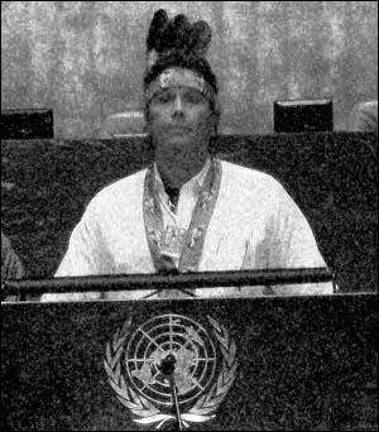Lenape lawsuit goes international

Milford man sets precedent appealing for help at the United Nations, By Anya Tikka UNITED NATIONS The legal battling has been stepped up a notch in the Sandhill Lenape Indians lawsuit against the State of New Jersey. Seeking to have the case moved to the World Court at The Hague, Lenape Chairman and Milford resident Ron Yonaguska Holloway spoke before the United Nations Permanent Forum on Indigenous Issues on April 20, appealing to that “astute body” for help restoring their international rights. This was the first time a Native American tribe has taken such a step.“What am I supposed to do?” asked the mild mannered Holloway, “I have to look after the needs of my people.” The Sandhills claim New Jersey and the United States government are failing to recognize the tribe’s right to exist and violating their basic human rights, and decided to appeal to the United Nations for help. The United Nations passed a new “United Nations Declaration on the Rights of Indigenous Peoples” resolution two years ago. Only a handful of nations failed to sign the declaration, among them the United States. Of special interest is Article 28, which states that indigenous peoples have the right to demand fair and equitable compensation for the lands that have been confiscated. The Sandhills believe their case is being stalled as a tactic, in hopes that the Lenapes will go away. The case, heard by Judge Katharine Sweeney Hayden in the US District Court in Newark, was originally to be decided in Sept. 2009. It wasn’t and following the Sandhill’s 2010 amendment to their arguments, Judge Hayden ruled that the scope of the case was too big. She’s currently in the process of reviewing all the relevant documents and facts, “for as long as it takes.” Claiming genocide and theft According to Holloway, New Jersey hunted down the Sandhills and seized their lands, and United States government ignored this, although it had agreed to uphold the original treaties signed by the colonists before the US existed, which granted Sandhill rights. “We claim rights to the whole of the New Jersey seaboard inland to the Delaware river,” said Holloway. Holloway said what happened amounts to genocide, contrary to the United Nations Declaration of Human Rights over 60 years ago, as well as the new Declaration of the rights of Indigenous People. “We did not have recourse to law since legally natives did not even have citizenship until 1924.” Despite the genocide, he says a tribal government continued underground and bloodlines did as well. “DNA testing (done by a museum) on 2,000 year-old remains proves a direct link to me personally from the original inhabitants of what’s now New Jersey,” Holloway claimed. And from here On the same day Holloway spoke there, the U.S. Ambassador to United Nations, Susan Rice released a statement saying the U.S. is reviewing its position about signing the Declaration of the Human Rights of Indigenous People. “I have great trust in (President) Obama,” said Holloway. Holloway still hopes the case will be resolved peacefully through talk and mediation. “We are not seeking to displace anybody, we are not looking to move people from their homes, or close administration buildings. We are open to negotiation and compensation in the form of (state owned) land... or monetary compensation.” If the United Nations Special Rapporteur on the Human Rights of Indigenous People, James Anaya finds the Sandhills have a case, he’ll recommend taking the case to the World Court for trial. For more on the UN agencies work, visit http://www2.ohchr.org/english/issues/indigenous/rapporteur/ .